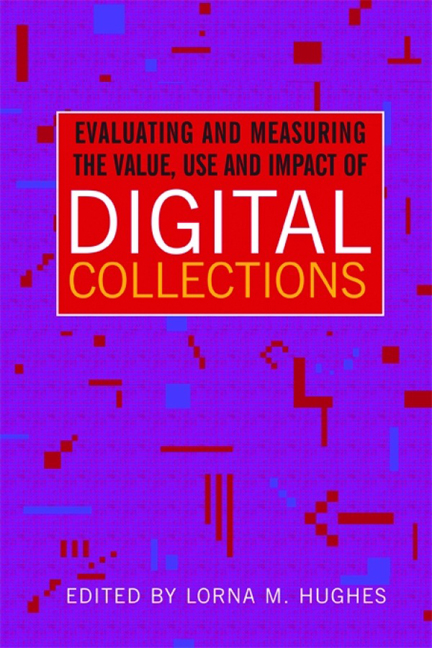Book contents
- Frontmatter
- Contents
- Figures and tables
- Foreword
- Acknowledgements
- The contributors
- 1 Introduction: the value, use and impact of digital collections
- Part 1 Digital transformations in libraries, museums and archives
- Part 2 Understanding and measuring the use, impact and value of digital collections
- 5 A strategic approach to the understanding and evaluation of impact
- 6 User needs in digitization
- 7 Measuring impact and use: scholarly information-seeking behaviour
- 8 The value and impact of digitized resources for learning, teaching, research and enjoyment
- Part 3 Enhancing the future impact and value of digital collections
- References and further reading
- Index
- Miscellaneous Endmatter
- Miscellaneous Endmatter
6 - User needs in digitization
from Part 2 - Understanding and measuring the use, impact and value of digital collections
Published online by Cambridge University Press: 08 June 2018
- Frontmatter
- Contents
- Figures and tables
- Foreword
- Acknowledgements
- The contributors
- 1 Introduction: the value, use and impact of digital collections
- Part 1 Digital transformations in libraries, museums and archives
- Part 2 Understanding and measuring the use, impact and value of digital collections
- 5 A strategic approach to the understanding and evaluation of impact
- 6 User needs in digitization
- 7 Measuring impact and use: scholarly information-seeking behaviour
- 8 The value and impact of digitized resources for learning, teaching, research and enjoyment
- Part 3 Enhancing the future impact and value of digital collections
- References and further reading
- Index
- Miscellaneous Endmatter
- Miscellaneous Endmatter
Summary
Introduction
Impact and value of digitized collections are concepts that are both being brought to real life through users. Any metrics and criteria that would try to capture impact and value have to factor in first how individual users (or user communities) benefit from the digitized resources in question.
Thus, one specific difficulty in measuring impact and value is the subjective and quickly changing user-related component of the valorization process. How exactly could we find out whether a digital resource had an impact on users? What value propositions have resource creators intended to convey to their target audiences? How well did these target audiences understand the message – is the value they see in the resource and surrounding services identical to what its producers had in mind? This chapter presents a description of user evaluation methodologies, and discusses how user considerations can be factored into the digitization process. It presents a case study describing user involvement in projects on digitization of audiovisual materials.
The user paradox: users are valuable in digitization policies but not sufficiently involved
As the volume of digitized resources grows, so does the number of studies and publications on user studies within the digital library domain, although these have been limited in scope, as noted recently by Michael Khoo and colleagues: ‘In the case of digital library researchers, the focus of research is often on technical issues (e.g., information retrieval methods, software architecture, etc.) rather than on user-centered issues’ (Khoo, Buchanan and Cunningham, 2009).
In fact, we are currently witnessing a paradox: major institutions from the cultural heritage sector clearly emphasize the place of user evaluation and feedback in digitizationrelated policies. But in reality, decisions about aspects of digitization that impact users are frequently taken without direct user involvement.
For example, the National Library of Australia Collection Digitisation Policy (National Library of Australia, 2008) states that: ‘The Library's digitisation activities take account of user evaluation and feedback. Users are encouraged to provide feedback and make suggestions through the Digital Collections user feedback form or other ways.’
Information
- Type
- Chapter
- Information
- Publisher: FacetPrint publication year: 2011
Accessibility standard: Unknown
Why this information is here
This section outlines the accessibility features of this content - including support for screen readers, full keyboard navigation and high-contrast display options. This may not be relevant for you.Accessibility Information
- 1
- Cited by
